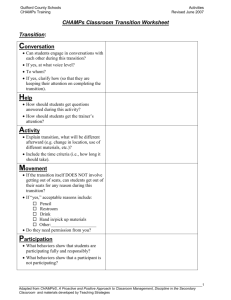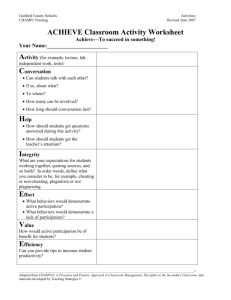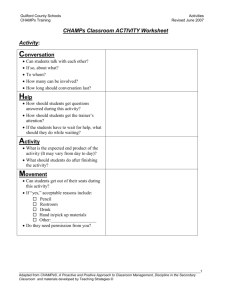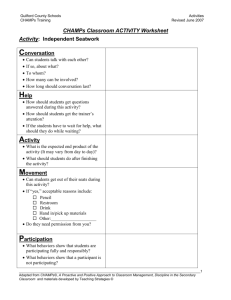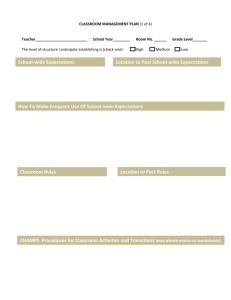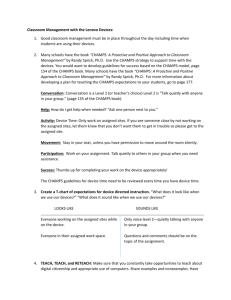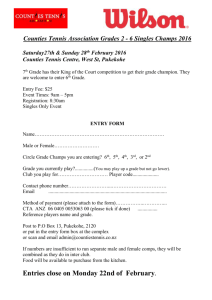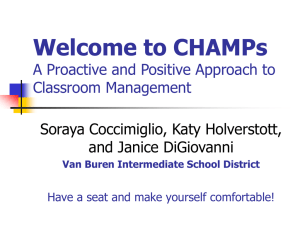CHAMPS-Positive Behavior Interventions and Support in the
advertisement
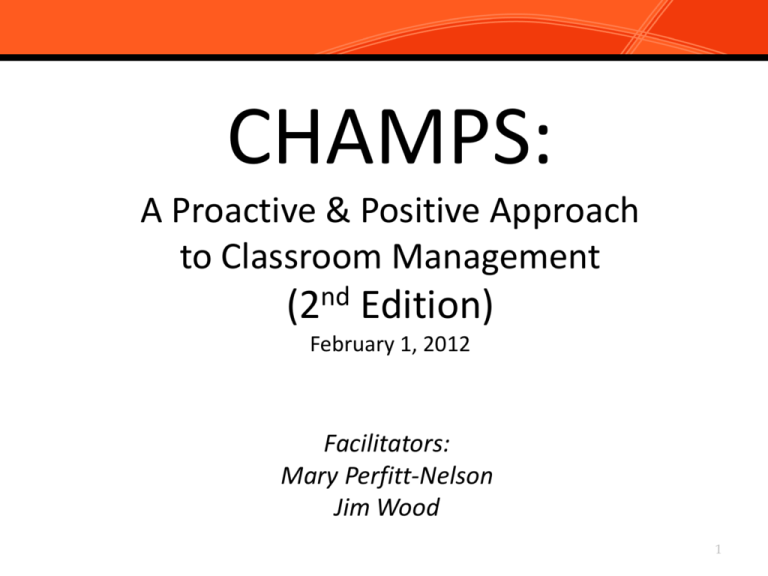
CHAMPS: A Proactive & Positive Approach to Classroom Management (2nd Edition) February 1, 2012 Facilitators: Mary Perfitt-Nelson Jim Wood 1 Ground Work • Cell Phones • Breaks • The Attention Signal • Lunch • Ending 2 The Great Divorce DAVID BROOKS New York Times 1/30/12 Charles Murray’s “Coming Apart” describes the most important cultural trends today and offers a better understanding of America’s increasingly twocaste society. http://www.nytimes.com/2012/01/31/opinion/brooks-the-greatdivorce.html?_r=2&hp 3 Introduction Overview: Setting The Stage Introduction (pages 1-12) The goal of classroom management is to develop a classroom of students who are: • respectful, • responsible, • ready to roll (i.e. motivated), • and responsive (i.e. highly engaged in meaningful tasks). 4 There are techniques and strategies that can improve student behavior, attitude, and motivation. 5 Understatement: “Not all students come to us motivated and/or responsible.” • Some are responsible and highly motivated. • Some are responsible, but only moderately motivated. • Some are like Huck Finn. Or MORE! 6 7 Overall organization of the book—see Table of Contents Video-Part 2: The Big Picture 8 The Big Picture An effective classroom management plan prevents misbehavior and is continually refined to help students become increasingly respectful, responsible, motivated, and highly engaged in instructional activities. Today we hope you will leave with a completed, comprehensive classroom management plan! 9 Where We Are Heading 10 11 We will • Cover chapters related , primarily, to the organization and management of the environment 12 Book Study: Motivating Reluctant Learners (2 Day Event) (Optional Follow Up to Building Effective Relationships workshop) Date(s): April 16 and May 1, 2012 13 Section 1 Structure Your Classroom for Success 14 Chapter 1 Vision Develop a Clear Vision for Your Class Pages 15- 61 15 Chapter 2 p 63-106 Organization Create Consistent Organizational Patterns 16 Tasks 1.Arrange and effective daily schedule (p64) 2.Create a positive physical space 3.Use an attention signals 4.Design effective beginning & ending routines 5.Manage student assignments 6.Manage independent work periods 17 Chapter 2, Task 1: page 64 Arrange an Efficient Daily Schedule – Refer to Pages 64-70 Ch. 2 Task One: Arrange an Efficient Daily Schedule – Provide enough VARIETY to increase time on task and interest • Write down your schedule of daily subjects, • List the activities inherent within each subject • Determine amount of time per activity and whether the activity is teacher directed (lecture, discussion, question/answer) or independent work (seatwork, lab) or a cooperative task. – Find BALANCE among types of activities: 40% teacher directed; 35% independent work; 25% cooperative groups – Avoid having any task run too long – Schedule independent work and cooperative/peer group tasks so that they immediately follow teacher-directed tasks 18 Task 2: Create a positive physical space • Read pages 70-76 • Discuss with table • Report relevant pieces to group 19 Task2,3:Task 3: Chapter Use an Attention signal Signal Create attention • Every teacher needs to have an attention signal • The goal is to have the attention of all within 5 seconds. • I have a specific plan for how I will provide both positive and corrective feedback to students regarding how they respond to the signal. 20 Chapter 2, Task 4: Task 4: Develop Design Effective Beginning andEffective Ending Routines Beginning and78-89 Ending Routines Pages Story……………VISUALIZE the end of your day •Video: Disc 2 Chapter 2 Task 4 •Complete section of the plan 21 Chapter 2, Task 5: Task 5: Managing Student Manage Student Assignments Assignments p. 90-98 • • • • Read pages 90-98 Discuss with table Report relevant pieces to group Complete section of plan 22 23 24 25 Chapter 2, Task 6:Periods Task 6: Manage Independent Work Manage Independent Work Periods p 99-104 Tips – Only assign independent work that I know students can do independently. – Schedule independent work times in a way that maximizes on-task behavior (see Task 1: Arrange an Efficient Daily Schedule). 26 Chapter 2, Task 6: Manage Independent Work Periods (Continued) – Establish a clear vision of what student behavior should look and sound like during independent work times. – Arrange to provide guided practice on tasks and assignments that I expect students to do independently. – Develop a specific system for how students can ask questions and get help during independent work periods. 27 28 Chapter 3 Creating a management plan 29 Chapter 3: Management Plan p 107-144 Tasks 1.Determine the level of classroom structure 2.Develop & display classroom rules 3.Correct rule violations during the first week of school 4.Establish corrective consequences for rule violations 5.Know when (& when not) to use disciplinary referral 30 Chapter 3, Task 1: Determine the Level of Classroom Structure p109-115 • What level of classroom structure do you need? – This is about two things: • YOUR preference/style • STUDENT characteristics 31 Activity Level of Structure (High, Middle, or Low) of Your Management Plan Fill out Figure 3.1 (page 111) and Reproducible 3.1 (page 112) of your CHAMPS book and total your scores. 32 33 34 “Survey says…” Score: 0-30 LOW: Students can be successful with LOW, MEDIUM, or HIGH 31-60 MEDIUM: Students need MEDIUM or HIGH structure 61-120 HIGH: Students need HIGH structure 35 Chapter 3, Task 1: Determine the Level of Classroom Structure (Continued) Re-evaluate – During the fourth or fifth week of school, I will evaluate how well students are meeting my expectations. – Shortly after winter and spring vacations, I will evaluate how well students are meeting my expectations. 36 Chapter 3, Task 2: Display Classroom Rules Develop and Display Classroom Rules p115-119 • Read Pages 115-119 • Discuss at table • Report Out 37 Expectations In The Classroom: Behavior Matrices • Your classroom rules are essentially found in a behavior matrix: 38 Chapter 4 Expectations Generate Clear Expectations Video: Ch 4 Intro: Teaching Expectations 39 Tasks p 1. Clarify CHAMPS expectations for Instructional activities 2. Clarify CHAMPS expectations for Transitions 3. Prepare lessons to communicate your expectations 40 Chapter 4, Task 1: Clarify CHAMPS Expectations for Instructional Activities Three-Step Process for Communicating Expectations Video: Disc 3 Ch 4 Task 1 41 42 43 Chapter 4, Task 2: Clarify CHAMPS Expectations for Transitions Repeat for TRANSITIONS 44 45 46 47 48 Chapter 4, Task 3: Prepare Lessons to Communicate Your Expectations • Video: Ch 4Task 3 • Discuss notes at table • Report Out To Group 49 Chapter 5 Launch Launch Your Management Plan in the First Month of School 50 Tasks 1. Summarize your classroom management & discipline plan 2. Make final preparations for Day One 3. Implement your plan on Day One 4. Implement your plan on Days 2 through 20 (the first 4 weeks) 5. Prepare your students for special circumstances 51 52 53 54 Mary Perfitt-Nelson Mary.perfitt.nelson@oakland.k12.mi.us Jim Wood Jim.Wood@oakland.k12.mi.us 55 Chapter 6 Observe Use Data to Monitor and Adjust Your Management Plan 56 Tasks Task One: Circulate and Scan Task Two: Use Data From Tools To Monitor Tools: 1. CHAMPS vs. Daily reality Rating Scale 2. Ratio of Interactions Monitoring Form 3. Misbehavior Recording Sheet 4. Grade Book Analysis Worksheet 5. On-Task Behavior Observation Sheet 6. Opportunities to Respond Observation Sheet 7. Family/Student Satisfaction Survey 57 Chapter 6, Task 1: Circulate When Possible, and Scan All Sections of the Classroom Continuously • Video: Ch 6, Task 1 58 Chapter 6, Task 2: Use Data to Monitor and Adjust Your Classroom Management and Discipline Plan 59 Tools for Monitoring 1. CHAMPS vs. Daily reality Rating Scale 2. Ratio of Interactions Monitoring Form 3. Misbehavior Recording Sheet 4. Grade Book Analysis Worksheet 5. On-Task Behavior Observation Sheet 6. Opportunities to Respond Observation Sheet 7. Family/Student Satisfaction Survey 60 Tool 1: CHAMPS versus Daily Reality Rating Scale Determine the degree to which student behavior during daily activities and transitions matches your CHAMPS expectations. Video: ch 6 task 1 61 WHY: To help you decide whether you need to re-teach your CHAMPS expectations • To help you decide whether your current level of structure fits the needs of your class • To help you decide whether you might need some kind of classwide system to increase students' motivation to behave responsibly WHEN: • During the fourth or fifth week of school • Shortly after major vacations (e.g., winter and spring breaks) 62 63 Tool 2: Ratio of Interactions Monitoring Form(s) Determine whether you are interacting with students at least three times more often when they are behaving responsibly than when they are misbehaving. Read: Page 251-256 64 WHY: • To help you evaluate whether you have fallen into the Criticism Trap—that is, whether you are responding so frequently to misbehavior that the behavior stops in the short run but is actually increasing over time • To help you decide whether you need to increase the number of interactions you have with students when they are behaving appropriately WHEN: • During the second month of school • In early to mid-February • Any time you sense that you are nagging a lot 65 66 Tools 3-7 Jigsaw 1. Misbehavior Recording Sheet (p 257) 2. Grade Book Analysis Worksheet (p262) 3. On-Task Behavior Observation Sheet(p264) 4. Opportunities to Respond Observation Sheet (p268) 5. Family/Student Satisfaction Survey (p271) 67
